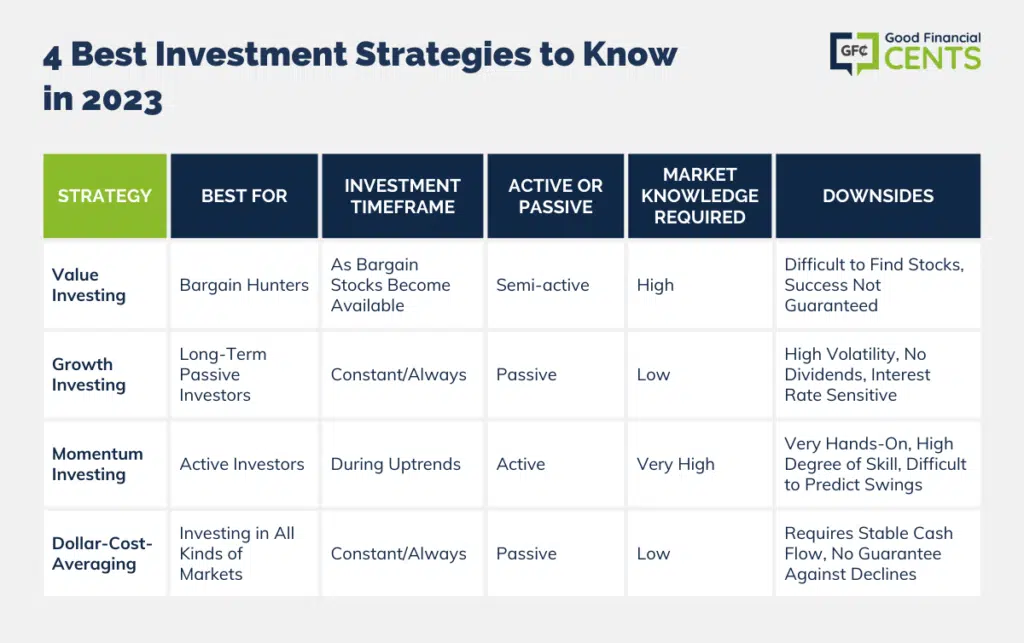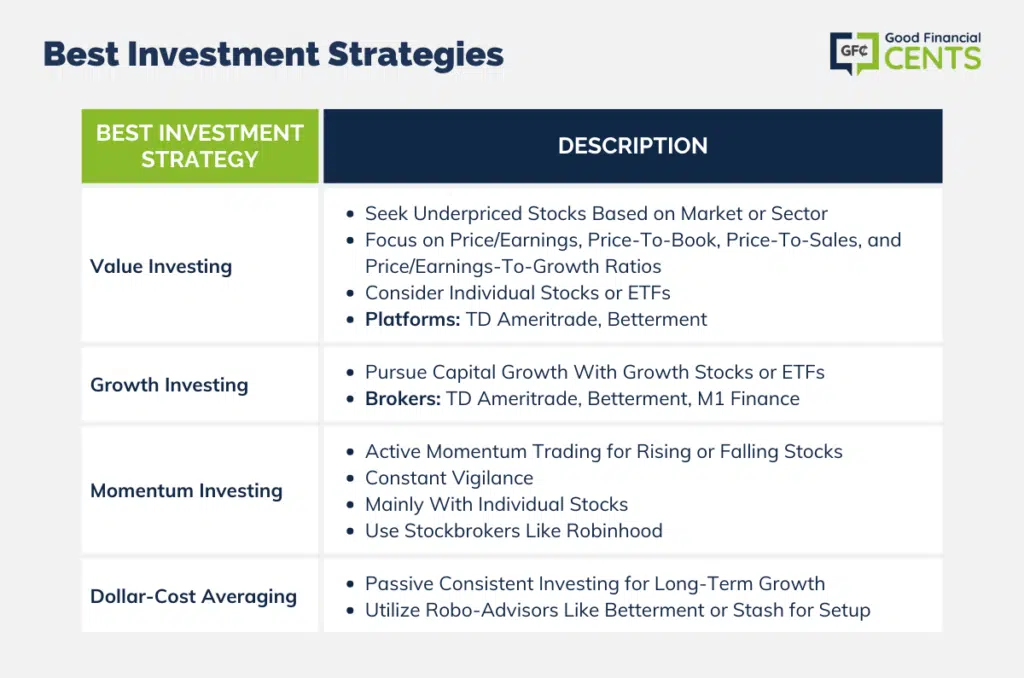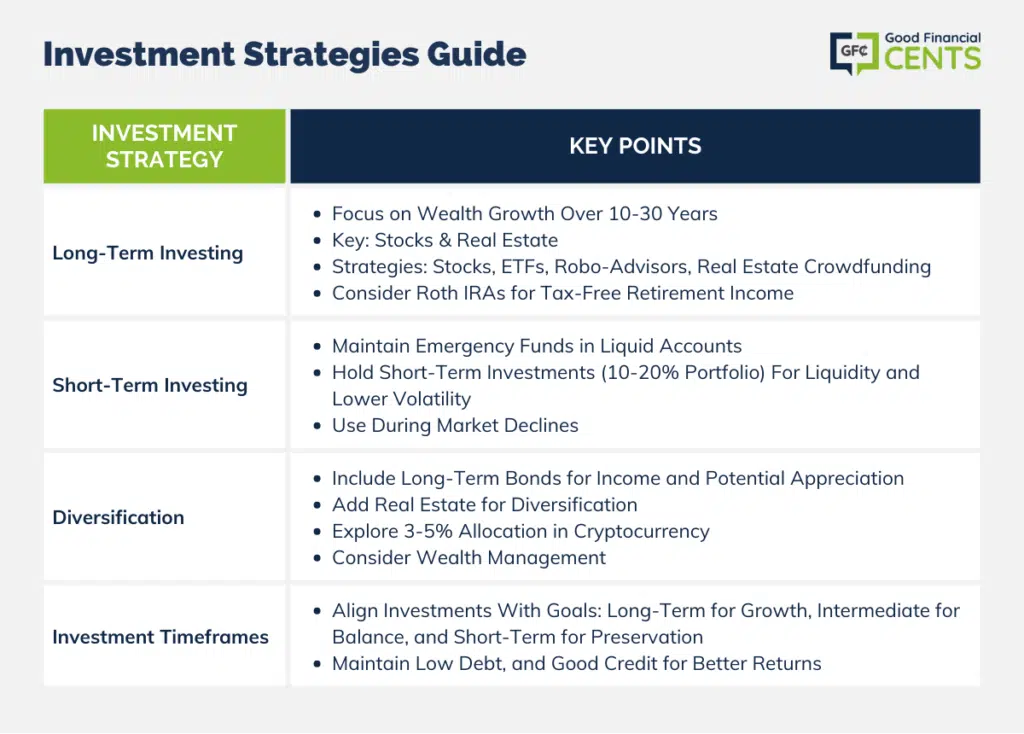| I’ve been investing with Fundrise since 2018. Disclosure: when you sign up with my link, I earn a commission. All opinions are my own. |
If you’ve been searching for a winning investment strategy, we’ve come up with what we believe to be the four best investment strategies for 2025.
Since investors all have their own unique “investor profile,” we’ve chosen four strategies that will fit most investor preferences.
The table below provides a summary of all four strategies, including what each is best for, its typical investment timeframe, whether it’s active or passive, the amount of market knowledge required, and the major downsides. Peruse the table, then read the detailed summaries for each below.

Our Picks for the 4 Best Investment Strategies for 2025
In contrast to our usual strategy, we’re not going to attempt to rank the four best investment strategies for 2025. Each has value to a certain group of investors.
Below is a listing of the four investment strategies, emphasizing below what we believe each is best for:
- Value Investing: Best for Bargain Hunters
- Growth Investing: Best for Long-Term Passive Investors
- Momentum Investing: Best for Active Investors
- Dollar-Cost Averaging: Best for Investing in All Kinds of Markets
No matter what investment strategy you choose, you’ll need a platform to invest on. Investigate the best online stock brokers for beginners and the best investment apps where you can trade and invest.
Also, be sure you understand what is a brokerage account and familiarize yourself with our guide to basic investing.
Investing has gotten much easier in recent years, but the more you know, the better your chances of success will be.
Now, let’s get on to the four best investment strategies for 2025:
Best Investment Strategies
Table of Contents
Value Investing: Best for Bargain Hunters
- Investment Timeframe: As bargain stocks become available
- Active or Passive: Semi-Active
- Market Knowledge Required: High
- Downsides: Difficult to find stocks, success not guaranteed
In some ways, value investing is the most time-honored method of investing. It’s a bargain-hunting strategy applied to stocks and is popularly used by Warren Buffett.
The basic concept is that you look for stocks that are underpriced relative to either the market or to a company’s specific industry sector. Once the general market recognizes the undervaluation of the company, its stock is expected to outperform its competitors.
A common valuation method is the price/earnings ratio or P/E ratio. If the P/E ratio of a company is 12, and the average for the industry sector is 22, all things being equal, the company is considered undervalued.
Other methods of valuation include price-to-book, price-to-sales, and price/earnings-to-growth (PEG) ratios.
There are different ways to invest in value stocks, including individual stocks and investing in ETFs that specialize in value stocks.
If you’re going to invest in either, consider a diversified brokerage platform like TD Ameritrade. Either will enable you to trade in either security.
Alternatively, you can consider a robo-advisor like Betterment. They hold your funds invested in US stocks in value stocks.
Growth Investing: Best for Long-Term Passive Investors
- Investment Timeframe: Constant/always
- Active or Passive: Passive
- Market Knowledge Required: Low
- Downsides: High volatility, no dividends, interest rate sensitive
Growth stocks may be the classic way to invest in the stock market. By definition, a growth stock is a company that plows its revenues into future growth. For that reason, they either pay very little in the way of dividends or none at all.
But growth investors aren’t looking for dividend income. Instead, the focus is on long-term capital appreciation. Growth stocks have a history of delivering superior long-term gains. This is particularly true of small-capitalization growth stocks, with their better and faster growth cycles. These are the proverbial situations where you buy a stock for $20 and watch it rise to $100 three years later. At least, that’s the hope.
But historically, the strategy has worked very well. What’s more, it’s a passive way to invest. You don’t have to concern yourself so much with individual stocks, but rather with ETFs that focus on growth stocks.
You can invest in growth stocks through any of the brokers listed above or through Betterment. But if you like to choose your own investments, consider M1 Finance.
Like Betterment, M1 Finance is a robo-advisor. But they let you choose your own individual stocks and ETFs. Once you do, they’ll provide professional management of your portfolio free of charge. It’s one of the very best robo-advisors available, representing a hybrid between automated management and self-directed investing.
Momentum Investing: Best for Active Investors
- Investment Timeframe: During uptrends
- Active or Passive: Active
- Market Knowledge Required: Very high
- Downsides: Very hands-on, high degree of skill, difficult to predict swings
This is a hands-on, higher-risk form of investing, and it’s not for everyone. The basic strategy is that the investor takes advantage of the momentum of the stock. That is, rising stocks continue to rise while falling stocks continue to fall.
The momentum investor can make money on either side of the equation. By buying rising stocks, the momentum investor is taking advantage of continued price growth. However, if he or she wants to benefit on the downside, it’s just a matter of short-selling the losing positions and allowing them to continue to decline. The investor makes money the more the stock drops in value.
Though this method of investing can be highly profitable in markets with clear directions, it’s not without its risks – and those are substantial.
First, this is not a passive investing strategy. The momentum trader must be constantly monitoring his or her portfolio, looking for positions to buy and sell as they develop.
Second, there’s a very real possibility of either the price of a stock or the direction of the market changing on short notice. If so, the momentum investor can be stuck with a group of stocks suddenly heading in the wrong direction.
While you can take advantage of momentum investing with funds, it’s most popularly done with individual stocks. The best accounts to use for momentum investing then will be stockbrokers, like Robinhood.
Dollar-Cost Averaging: Best for Investing in All Kinds of Markets
- Investment Timeframe: Constant/always
- Active or Passive: Passive
- Market Knowledge Required: Low
- Downsides: Requires stable cash flow, no guarantee against declines
Dollar-Cost-Averaging (DCA) is the preferred investment strategy of the masses. That’s because it’s a completely passive and hands-off way to invest. It’s so efficient you don’t even need to worry about timing the market.
The strength of DCA is its simplicity. You choose a flat amount of money to invest on a regular basis, like weekly, monthly, or contributed out of your paycheck.
Since the same amount of money is going into your investment account on a regular basis, you continue to build principal. The funds are distributed into a predetermined portfolio mix. That may include a mix of stocks, bonds, cash, and other investments.
The investment strategy itself is almost self-monitoring. Because you’re always investing the same amount of money, you’ll be purchasing fewer shares of stocks or funds when prices are higher. But when prices are lower, your fixed contributions will purchase more shares. That’ll give you a built-in strategy of buying when prices are low and buying less when prices are high.
Despite that advantage, DCA does not guarantee you’ll never lose money. Just as is the case with any other type of investing, your portfolio can decline in value during a general market downturn.
However, the steady investing practice almost guarantees long-term success. You can take advantage of dollar-cost-averaging by setting up regular contributions to the best robo-advisors.
If you’re a new investor looking to accumulate the funds to invest, consider a robo-advisor like Stash. But for most other investors, Betterment will work just fine with dollar-cost-averaging.

Investment Strategies Guide
Long-Term Investing
In some ways, long-term investing is the key to all investing. That’s because the ultimate goal is to make sure your wealth grows over the long term. After all, an investment portfolio will rise and fall in the short run. But what really matters with investing is where your portfolio is in 10, 20, or 30 years.
For that reason, familiarize yourself with the best long-term investments. These include, first and foremost, stocks and real estate.
With stocks, you can take advantage of the four best investment strategies we’ve laid out above. That can be done with either individual stocks or with ETFs, and through self-directed investing or by using robo-advisors – it’s your choice.
In most respects, however, real estate will be a more complicated addition to your portfolio. That’s because the high cost of real estate means it will require large amounts of capital to participate. That is if you invest in individual properties.
A simple alternative is to take advantage of real estate crowdfunding platforms. These are online peer-to-peer investment platforms, where investors put up the money that’s invested by deal sponsors. Most of the deals are invested in commercial property, like retail space, office buildings, and large apartment complexes.
But the advantage of real estate crowdfunding is that all you need to do is put up money. The sponsors manage the project for you. You’ll then receive regular dividend income, a large cash payout at the end of the term, or a combination of both.
One of the best real estate and private asset platforms is Fundrise. It offers investors of all sizes the ability to participate in commercial real estate investing with a minimum investment of $10.
Roth IRAs
And speaking of long-term investing, you may also want to consider opening a Roth IRA. It offers the prospect of tax-free income in retirement. Check out the best Roth IRAs, see which one will work best for you, and open an account today.
Short-Term Investing
As important as long-term investing is as a base investment strategy, short-term investing has an important place in your portfolio.
First and foremost is an emergency fund. The purpose of the fund isn’t just to have money available for emergencies, but also to prevent you from liquidating your investment portfolio in a time of need. That can force you to sell an investment at a loss to cover a short-term emergency.
The best type of account to park an emergency fund in is a highly liquid bank account. That can include a money market account or a savings account. Even if it doesn’t pay much interest, the money will be there when it’s needed.
Otherwise, investigate the best short-term investments to add to your portfolio for liquidity purposes.
No matter how aggressively you invest, at least a small portion of your portfolio should be held in short-term investments. This will provide the liquidity needed to take advantage of investment opportunities as they arise. This will be especially important during market declines, when “stocks go on sale”. You can then liquidate short-term investments to purchase stocks at very low prices.
Short-term investments also provide another very important function. By having at least 10% or 20% of your portfolio in safe investments, you can reduce the volatility in your portfolio.
For example, let’s say 100% of your portfolio is in stocks. If the market experiences a 25% decline, your portfolio will drop by 25%.
But if 80% are in stocks and 20% are in short-term investments, a 25% hit to stocks will reduce your portfolio by just 20%.
The Importance of Diversification
The example given above demonstrates the importance of diversification, at least as far as including short-term investments in your portfolio. But diversification goes beyond short-term investments.
You may also want to hold long-term bonds in your portfolio. Not only do they provide a higher level of income than short-term investments, but if interest rates fall in the future, long-term bonds can produce capital appreciation.
We’ve already discussed the importance of real estate in a portfolio. While it works much the way stocks do to provide long-term growth, it’s a diversification away from an all-paper portfolio. Real estate is, after all, a “real asset”. There is great potential for it to provide positive returns, even while paper investments, like stocks, are in decline.
Still, another portfolio diversification that has been coming up rapidly in recent years is cryptocurrency. Though it’s only been around since 2009, crypto – particularly Bitcoin – has easily outperformed both stocks and real estate.
Familiarize yourself with how to invest in Bitcoin and other cryptocurrencies. You don’t need to put a large percentage of your portfolio in crypto. 3% to 5% will be all you’ll need. That will minimize the risk of large losses but enable you to participate in big gains.
To invest in crypto, you’ll also need to learn about the best crypto exchanges. Only a handful of mainstream investment brokers allow you to invest in crypto, so crypto exchanges are the best play with this asset class.
If you have extra time, read Jeff Rose’s insightful Four Ways I’m Making Money with Crypto. It turns out there are several ways to make money with crypto.
Finally, if you have multiple investment accounts, you may want to engage the services of a wealth management provider. An example is Personal Capital. They’ll manage multiple accounts for a single annual flat fee.
Timing Your Investment With Your Goals
Let’s state fundamentally that there is no way to time the investment markets with any degree of certainty. But you can engage in a bit of timing with your investment goals.
For example, you should have long-term investment goals, primarily retirement. But you may also have long-term goals for projects like financing your children’s college educations or paying off your mortgage.
You may also want to have an intermediate investment bucket. That may include saving up the money for the down payment on a house, periodically replacing your car, or forming the future dream of buying a vacation home.
On the short-term side, you may want to have investment goals for saving for a vacation, planning for a wedding, or even for a long-awaited cosmetic surgery.
Each type of investment, whether long, intermediate, or short-term, should be properly invested for the appropriate time horizon.
For example, long-term investments should be held primarily in growth assets, like stocks and real estate. Intermediate investment goals should focus on more conservative growth-oriented assets, like a lower mix of stocks, with a large amount of bonds. Finally, short-term investment goals should be held in short-term investments likely to hold their value.
But along the way, be sure to maintain your credit in good order. No matter how large your investment portfolio, you should keep your debt to an absolute minimum.
A home mortgage and car loan may be inevitable, but having tens of thousands of dollars in credit card debt makes no sense, even if you have a large investment position.
The interest you’ll pay on credit card debt is just too high to be justified by the investment returns.
And if you have credit issues, investigate the best credit repair services. Bad credit can cost you more in interest than you’re earning on your investments. Be sure to fix any credit problems as they arise.

How We Found the Best Investment Strategies
In coming up with our list of the four best investment strategies for 2025, we relied heavily on the following five criteria:
- Best For: An investment strategy has merit only if it will work well for a large number of investors.
- Investment Timeframe: It’s important for investors to know if a strategy is designed for the long term or the short term. Investors show a definite preference for either.
- Active or Passive: Many investors want to invest their money but keep busy doing other things. Passive investing is the better choice for them. Others want to participate in the process, which favors active investing.
- Market Knowledge Required: Each of the four strategies requires a different level of knowledge. The more active the strategy, the greater the knowledge level required.
- Downsides: Just as it’s important for investors to know the basic styles of each investment strategy, they must also know any potential negatives. There are two or three associated with each strategy, and you must be comfortable with those outcomes.
In addition, we also consider the popularity of each of the four investment strategies we’ve presented. Each is popular precisely because it does appeal to a large slice of the investment population.
Summary of the Best Investment Strategies
The summarize, below are what we believe to be the four best investment strategies for 2024, as well as who we think each strategy is best for:
- Value Investing: Best for Bargain Hunters
- Growth Investing: Best for Long-Term Passive Investors
- Momentum Investing: Best for Active Investors
- Dollar-Cost Averaging: Best for Investing in All Kinds of Markets
Whatever strategy you choose, it’s important to pick one. There are no magic bullets when it comes to investing. The most important strategy is to participate in the process, and to do it on a consistent basis. Exactly how you do that, even if it’s completely passive, will be far better than doing absolutely nothing.
Bottom Line: Top 4 Investment Strategies for 2025
In the dynamic investment landscape of 2025, four distinct strategies have emerged as prime options. Tailored to various investor profiles, these strategies offer different timeframes, levels of involvement, and potential risks.
Value Investing targets bargain hunters, seeking undervalued stocks using methods like P/E and PEG ratios. Growth Investing suits long-term passive investors, aiming for capital appreciation through growth stocks or ETFs. Momentum Investing caters to active investors, leveraging market momentum to gain from rising or falling stocks.
Dollar-cost averaging is ideal for consistent, passive investing across various market conditions. Whichever path you choose, the key lies in consistent participation aligned with your goals.








Leave a Reply